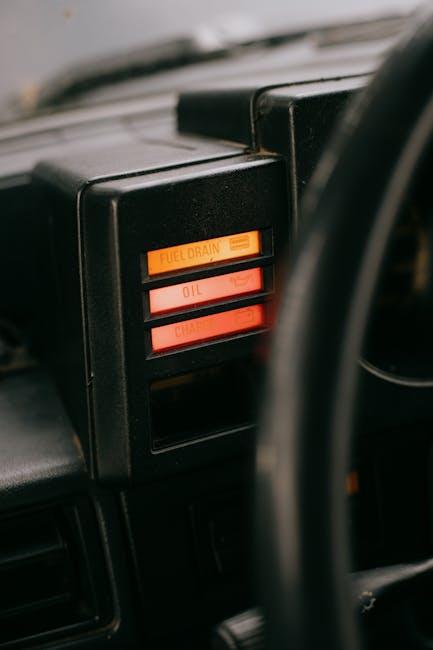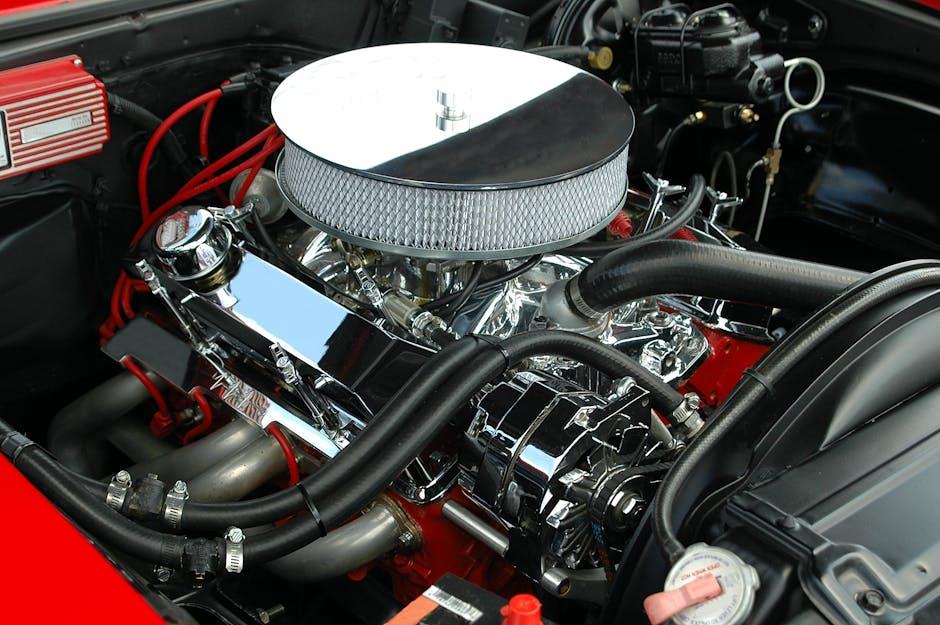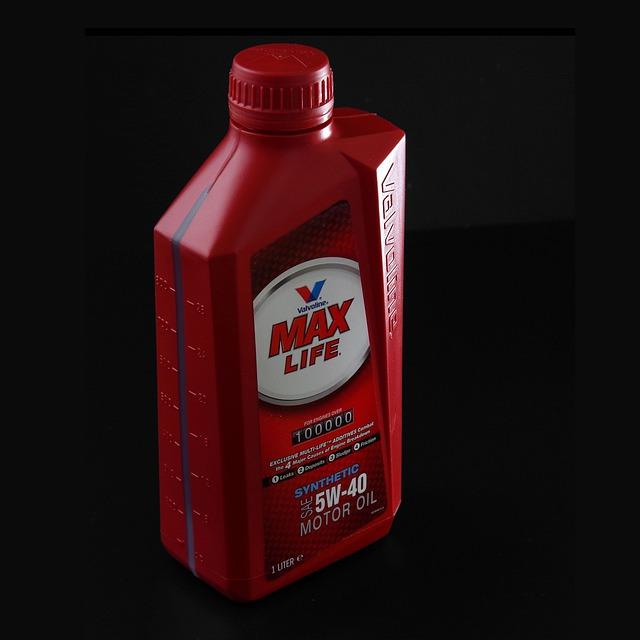Every vehicle tells a story, and one of its most persistent narrators is the oil change light. Flickering to life on your dashboard, this little beacon signals it’s time to care for your engine with fresh oil. But once the job is done, how do you quiet this vigilant reminder? Resetting the oil change light might seem like a small task, but it’s an important step in keeping your dashboard—and your car—running smoothly. In this article, we’ll guide you through the simple yet essential process of turning off that light, ensuring your vehicle stays in tune with its maintenance needs.
Table of Contents
- Understanding the Purpose of the Oil Change Light
- Common Reasons the Oil Change Light Stays On
- Step-by-Step Guide to Resetting the Oil Change Light
- Best Practices Before Resetting the Oil Change Light
- Troubleshooting Persistent Oil Change Light Issues
- Maintaining Your Vehicle for Optimal Oil Change Intervals
- Q&A
- To Wrap It Up

Understanding the Purpose of the Oil Change Light
The oil change light serves as a crucial reminder from your vehicle’s internal system, alerting you when it’s time to replace the engine oil. Modern cars use sensors to monitor oil quality and engine performance, ensuring your engine stays lubricated and doesn’t suffer from wear and tear. When this light illuminates, it’s not just a simple notification—it’s a prompt that persistent neglect could lead to reduced efficiency, increased emissions, or even costly engine damage. Recognizing its role helps drivers maintain their vehicle’s health proactively.
Understanding when and why this light comes on can save you both time and money. Here’s what it typically indicates:
- Oil Degradation: Over time, engine oil breaks down, losing its ability to lubricate effectively.
- Scheduled Maintenance: Your car’s computer tracks mileage intervals to advise regular oil changes.
- Sensor Alerts: Faulty sensors might sometimes trigger the light, signaling a potential issue beyond oil quality.
| Condition | Oil Change Light Status | Recommended Action |
|---|---|---|
| Fresh Oil | Off | No action needed |
| Oil Near Expiry | On (flashing) | Prepare for oil change soon |
| Oil Expired | On (steady) | Change oil immediately |

Common Reasons the Oil Change Light Stays On
Sometimes, even after changing the oil, the oil change light refuses to turn off. This can be frustrating, but it often points to a few common culprits. One frequent issue is that the oil filter sensor might be malfunctioning or dirty, sending incorrect signals to the dashboard. Another possibility is that the vehicle’s computer system needs to be manually reset; many modern cars don’t automatically reset the indicator once maintenance is completed. Additionally, using the wrong type of oil or low oil levels can keep the warning light illuminated despite a recent oil change.
Understanding the root cause often involves checking a few key factors. Here’s a quick overview to troubleshoot:
- Oil Quality: Ensure the oil meets manufacturer specifications.
- Oil Level: Low engine oil might trigger the warning light.
- Sensor Condition: A faulty sensor may need replacement or cleaning.
- System Reset: Manually resetting the oil light might be necessary after maintenance.
| Reason | Solution |
|---|---|
| Dirty Oil Sensor | Clean or replace sensor |
| Incorrect Oil Type | Use recommended oil |
| Low Oil Level | Top up oil |
| Unreset System | Manual reset required |

Step-by-Step Guide to Resetting the Oil Change Light
Begin by turning your ignition key to the “on” position, but avoid starting the engine. This “ignition on” state is crucial as it powers the dashboard electronics without engaging the motor. Next, locate the reset button or trip odometer button on your dashboard, often near the speedometer or tachometer. Press and hold this button firmly until the oil change light starts flashing or turns off—typically between 10 to 30 seconds. Some vehicles may require cycling the ignition off and on while holding the button, so don’t hesitate to try this method if the first attempt doesn’t work.
- Turn ignition to “on” without starting the car
- Locate and press the reset or trip button
- Hold until oil change light blinks or disappears
- If needed, cycle ignition while holding the button
For those who prefer a more detailed approach or own newer vehicles, this process might differ slightly and require navigating the dashboard menu system. Use your steering wheel buttons or infotainment touchscreen to access vehicle settings or maintenance menus. Here, you’ll find options to reset the oil life or service light manually. Finally, ensure your success by turning off the ignition and starting the engine to confirm the oil change light remains off, signaling the reset was completed correctly.

Best Practices Before Resetting the Oil Change Light
Before resetting the oil change light, it’s crucial to ensure that the oil in your vehicle is fresh and at the correct level. Simply turning off the reminder without performing the actual oil change can lead to engine performance issues and reduce the lifespan of your vehicle. Take a moment to check the oil dipstick for clarity and quantity, and if the oil looks dark or gritty, it’s definitely time for a replacement. Additionally, always use the oil type recommended by your car’s manufacturer to maintain optimal engine health.
Equally important is to reset the oil change light only after completing the full maintenance procedure. Here are some essential steps to follow before pressing that reset button:
- Confirm the oil type and quantity are as specified in the owner’s manual.
- Inspect the oil filter and replace it if necessary to ensure proper oil flow.
- Clear any error codes with an OBD-II scanner if the light was triggered erroneously.
- Make note of the date and mileage once the oil change is completed for your records.

Troubleshooting Persistent Oil Change Light Issues
When the oil change light refuses to turn off after a reset, it typically signals an underlying issue that must be addressed rather than ignored. Start by double-checking if the oil change was performed correctly—sometimes the wrong procedure or incompatible oil types can cause sensors to malfunction. Also, inspect the vehicle’s oil sensor for dirt, damage, or loose connections, as these physical interferences can falsely trigger the alert. Resetting without addressing these factors often results in the light reappearing.
To methodically diagnose persistent problems, consider the following troubleshooting steps:
- Verify the oil filter is installed properly and isn’t clogged.
- Use an OBD-II scanner to check for error codes related to the oil system.
- Inspect for software updates for your vehicle’s ECU that might fix sensor calibration.
- Consult the vehicle’s manual for specific reset procedures unique to your make and model.
| Common Causes | Recommended Action |
|---|---|
| Incorrect oil type | Use manufacturer-specified oil |
| Faulty oil sensor | Replace or clean sensor |
| Improper reset procedure | Follow vehicle-specific reset method |
| Software glitch | Update ECU software |

Maintaining Your Vehicle for Optimal Oil Change Intervals
Keeping your vehicle in top condition is crucial for maintaining optimal oil change intervals and prolonging engine life. Regularly check fluid levels, tire pressure, and engine performance to ensure your oil stays effective longer. Clean air filters and timely spark plug replacements can also reduce engine strain, indirectly extending the period between oil changes. Remember, a well-maintained car not only improves fuel efficiency but also decreases the likelihood of unexpected mechanical failures.
Incorporate these simple yet effective habits into your maintenance routine to maximize oil life:
- Use manufacturer-recommended oil types and grades
- Monitor dashboard indicators and act promptly
- Schedule regular tune-ups with certified technicians
- Drive smoothly to minimize engine stress and oil degradation
| Maintenance Task | Frequency | Impact on Oil Life |
|---|---|---|
| Air Filter Replacement | Every 12,000 miles | Improves air flow, reduces engine strain |
| Spark Plug Checks | Every 30,000 miles | Ensures optimal combustion efficiency |
| Oil Filter Replacement | With every oil change | Keeps oil clean, enhances engine protection |
Q&A
Q&A: How to Reset Your Oil Change Light
Q1: What exactly is the oil change light on my dashboard?
A1: The oil change light is a handy indicator that reminds you when it’s time to change your engine oil. It’s triggered by the vehicle’s computer monitoring your mileage or oil quality, ensuring your engine stays lubricated and runs smoothly.
Q2: When should I reset the oil change light?
A2: Reset the light only after you’ve completed an oil change service. This ensures the reminder system accurately tracks the time or mileage for your next oil change, maintaining optimal engine health.
Q3: Is resetting the oil change light difficult?
A3: Not at all! Most vehicles have straightforward reset procedures, often involving a sequence of button presses or ignition key turns. Your owner’s manual is the best guide, but a quick online search with your car’s make and model can also help.
Q4: Can I reset the oil change light without changing the oil?
A4: While it’s technically possible, skipping the oil change and resetting the light can harm your engine over time. The light is a maintenance reminder, not just a gadget—honor its warning to keep your car running smoothly.
Q5: What’s a common method to reset the oil change light?
A5: A common method is turning the ignition to the “On” position without starting the engine, then pressing and holding the trip reset button until the light blinks or turns off. This varies by vehicle, so check your manual for specifics.
Q6: Will resetting the light improve my car’s performance?
A6: Resetting the light itself doesn’t affect performance. However, timely oil changes, which the light prompts you to perform, are crucial for engine efficiency, preventing wear and overheating.
Q7: What if the oil change light won’t reset?
A7: If the light persists after an oil change and reset attempts, there could be an issue with the sensor or the vehicle’s computer. It’s wise to visit a mechanic for a diagnostic check to avoid potential engine damage.
Q8: Can I reset the oil change light myself or should I see a professional?
A8: Most drivers can reset the light themselves following instructions in the manual. However, if you’re uncomfortable or the procedure doesn’t work, a professional mechanic can help ensure everything’s in order.
Q9: Does every car have an oil change light?
A9: Not every car has a dedicated oil change light; some use maintenance reminder systems or mileage trackers. Regardless, the principle is the same—stay on top of your oil changes for a healthy engine.
Q10: Why is it important to pay attention to the oil change light?
A10: Ignoring the oil change light can lead to degraded engine oil, increased friction, and eventual engine damage. Treat the light as your car’s way of asking for a little TLC to keep running at its best.
To Wrap It Up
Resetting your oil change light may seem like a small task, but it’s a key step in keeping your vehicle’s maintenance on track. By following the right steps, you can ensure your dashboard remains a clear guide rather than a constant reminder of past service. Whether you’re a seasoned car enthusiast or a first-time diyer, mastering this simple reset adds another skill to your automotive know-how. So next time that light flickers on, you’ll be ready—not just to change the oil, but to confidently reset the signal and hit the road with peace of mind.

